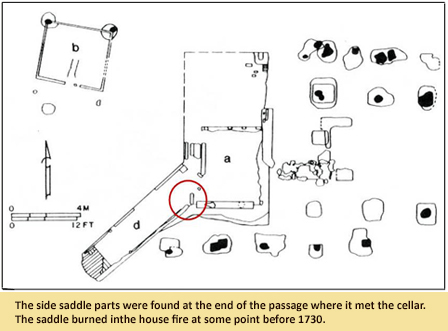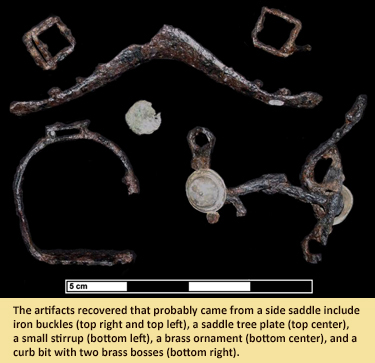Curator's Choice 2012
A Colonial Side Saddle
July 2012
By Sara Rivers Cofield, MAC Lab Curator of Federal Collections
 The Addison/Oxon Hill plantation was founded by John Addison and his family in the late 1680s. By 1730, the original dwelling at the site, which had a large underground cellar with a sloping passageway for access, had burned down. The fire caused the collapse of the passageway and cellar ceilings, whichwere filled with debris from the destruction. The Addisons were living in a bigger house elsewhere on the property by then, so they never rebuilt on the site. This is great for archaeologists because whole objects were left where they had been when people originally put them away. Based on the artifacts recovered, it seems that one of the things the Addisons had stored where the passageway entered the cellar was a side saddle.
The Addison/Oxon Hill plantation was founded by John Addison and his family in the late 1680s. By 1730, the original dwelling at the site, which had a large underground cellar with a sloping passageway for access, had burned down. The fire caused the collapse of the passageway and cellar ceilings, whichwere filled with debris from the destruction. The Addisons were living in a bigger house elsewhere on the property by then, so they never rebuilt on the site. This is great for archaeologists because whole objects were left where they had been when people originally put them away. Based on the artifacts recovered, it seems that one of the things the Addisons had stored where the passageway entered the cellar was a side saddle.
 A side saddle is a saddle made for female riders to allow them to ride facing forward, but with both legs on the same side of the horse to retain modesty while wearing a long skirt. In the 17th and 18th centuries, these saddles were made with many materials. They had a wooden base known as a saddle tree, and metal brackets might be used to strengthen the tree. Layers of padding and leather were then secured to the tree with metal nails and brass tacks, depending on the style of saddle. Various iron buckles allowed you to attach straps to the saddle to secure it on the horse or hang holsters or luggage. Leather straps for the saddle and bridle might be decorated with brass ornaments, and the bridle bit that went in the horse’s mouth to allow the rider to guide the horse could have brass bosses for decoration as well. Archaeologists are not likely to find the leather, padding, or wood, because these organic materials rot or get eaten by organisms that live in the soil. But we do find the metal parts, and when we find them all together, as is the case with this saddle, it can indicate that they were once part of one larger object. There is a small jointed curb bit with two brass bosses, a metal plate that strengthened the saddle tree, a brass ornament, an assortment of buckles, and a stirrup.
A side saddle is a saddle made for female riders to allow them to ride facing forward, but with both legs on the same side of the horse to retain modesty while wearing a long skirt. In the 17th and 18th centuries, these saddles were made with many materials. They had a wooden base known as a saddle tree, and metal brackets might be used to strengthen the tree. Layers of padding and leather were then secured to the tree with metal nails and brass tacks, depending on the style of saddle. Various iron buckles allowed you to attach straps to the saddle to secure it on the horse or hang holsters or luggage. Leather straps for the saddle and bridle might be decorated with brass ornaments, and the bridle bit that went in the horse’s mouth to allow the rider to guide the horse could have brass bosses for decoration as well. Archaeologists are not likely to find the leather, padding, or wood, because these organic materials rot or get eaten by organisms that live in the soil. But we do find the metal parts, and when we find them all together, as is the case with this saddle, it can indicate that they were once part of one larger object. There is a small jointed curb bit with two brass bosses, a metal plate that strengthened the saddle tree, a brass ornament, an assortment of buckles, and a stirrup.
 So even without the whole object, we can infer that this was probably either a side-saddle or a child’s saddle with a stirrup missing. Either way, this artifact tells us a lot about the people who lived at the site. Not all women and children learned how to ride a horse because you had to have specialized horse furniture, time to practice and take lessons, and usually a small, compliant, and well trained horse. Social norms at the time dictated that only men could handle more feisty steeds, and women and children of lesser means probably had work and chores that would prevent the serious pursuit of horsemanship. We already knew that the Addisons were a wealthy family who could afford the hobbies deemed appropriate for the upper classes, but there were many options for the gentry as they sought to enjoy their leisure time, and it is not always possible to figure out what people actually did. Thanks to this find, we now know that at least one member of the family chose to ride.
So even without the whole object, we can infer that this was probably either a side-saddle or a child’s saddle with a stirrup missing. Either way, this artifact tells us a lot about the people who lived at the site. Not all women and children learned how to ride a horse because you had to have specialized horse furniture, time to practice and take lessons, and usually a small, compliant, and well trained horse. Social norms at the time dictated that only men could handle more feisty steeds, and women and children of lesser means probably had work and chores that would prevent the serious pursuit of horsemanship. We already knew that the Addisons were a wealthy family who could afford the hobbies deemed appropriate for the upper classes, but there were many options for the gentry as they sought to enjoy their leisure time, and it is not always possible to figure out what people actually did. Thanks to this find, we now know that at least one member of the family chose to ride.
| References |
|
| Beatie, Russel H. |
| 1981 |
Saddles. University of Oklahoma Press, Norman, Publishing Division of the University. Chapter 15: 119-121. U.S. |
|